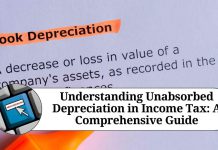Section 89(1) of the Income Tax Act is a provision that provides relief to taxpayers who have received arrears or advance salary in a financial year due to reasons such as a salary hike, promotion, or a job change. This provision applies to both salaried and non-salaried taxpayers who receive arrears or advance salary in a particular financial year. In this blog, we will discuss the provisions of section 89(1) of the Income Tax Act in detail.
What is Section 89(1) of the Income Tax Act?
Section 89(1) of the Income Tax Act provides relief to taxpayers who have received arrears or advance salary in a financial year. The relief is provided in the form of the computation of tax on the total income of the taxpayer. This is done by spreading the arrears or advance salary over the financial years to which it pertains.
For example, if an individual receives arrears of salary for the financial year 2021-22 in the financial year 2022-23, the tax liability for the financial year 2022-23 will be calculated as if the individual had received the salary in the financial year 2021-22. This ensures that the individual is not taxed at a higher rate in the year in which he receives the arrears or advance salary.
Who can claim relief under Section 89(1)?
Relief under section 89(1) can be claimed by both salaried and non-salaried taxpayers who receive arrears or advance salary in a financial year. However, it is important to note that relief can only be claimed if the taxpayer has received the arrears or advance salary in a lump sum or more than one installment.
How is relief under Section 89(1) calculated?
The relief under section 89(1) is calculated using the following formula:
Step 1: Calculate the tax payable on the total income of the taxpayer in the year in which the arrears or advance salary is received.
Step 2: Calculate the tax payable on the total income of the taxpayer in the year to which the arrears or advance salary pertains, as if the arrears or advance salary had been received in that year.
Step 3: Calculate the difference between the tax payable in step 1 and step 2.
Step 4: Spread the difference calculated in step 3 over the financial years to which the arrears or advance salary pertains, starting with the earliest year.
Step 5: Calculate the tax payable for each year after spreading the difference in step 4.
Step 6: Add up the tax payable for each year calculated in step 5. The total amount of tax payable after relief under section 89(1) is the sum of the tax payable for each year in step
Relief under Section 89(1) can be claimed by both salaried and non-salaried taxpayers who receive arrears or advance salary in a financial year. However, it is important to note that relief can only be claimed if the taxpayer has received the arrears or advance salary in a lump sum or more than one installment.
For Example
Suppose an individual receives arrears of salary amounting to Rs. 5,00,000 in the financial year 2022-23. However, the arrears pertain to the financial year 2019-20. The individual’s income for the financial year 2019-20 was Rs. 10,00,000, and the tax payable was Rs. 1,50,000. The income for the financial year 2022-23, without considering the arrears, is Rs. 12,00,000, and the tax payable is Rs. 3,00,000.
Read more useful content:
- section 145 of income tax act
- section 10e of income tax act
- section 9 of the income tax act
- section 94b of income tax act
- section 206aa of income tax act
Here are some frequently asked questions about Section 89(1) of the Income Tax Act:
What is the purpose of Section 89(1) of the Income Tax Act?
Section 89(1) of the Income Tax Act is a provision that provides relief to taxpayers who have received arrears or advance salary in a financial year. This relief is provided by spreading the arrears or advance salary over the financial years to which it pertains, ensuring that the taxpayer is not taxed at a higher rate in the year in which he or she receives the arrears or advance salary.
Who can claim relief under Section 89(1)?
Relief under Section 89(1) can be claimed by both salaried and non-salaried taxpayers who receive arrears or advance salary in a financial year. However, it is important to note that relief can only be claimed if the taxpayer has received the arrears or advance salary in a lump sum or more than one installment.
How is relief calculated under Section 89(1)?
Relief under Section 89(1) is calculated by comparing the tax payable on the total income of the taxpayer in the year in which the arrears or advance salary is received with the tax payable on the total income of the taxpayer in the year to which the arrears or advance salary pertains, as if the arrears or advance salary had been received in that year. The difference between the two amounts is then spread over the financial years to which the arrears or advance salary pertains.
What is the benefit of claiming relief under Section 89(1)?
Claiming relief under Section 89(1) can help taxpayers avoid being taxed at a higher rate in the year in which they receive arrears or advance salary. By spreading the income over the financial years to which it pertains, taxpayers can reduce their tax liability and potentially save money.
How can taxpayers claim relief under Section 89(1)?
Taxpayers can claim relief under Section 89(1) by submitting Form 10E to the Income Tax Department. The form should include details of the arrears or advance salary received and the financial years to which it pertains. The relief will then be calculated by the Income Tax Department and reflected in the taxpayer’s tax liability for the relevant financial years.




















